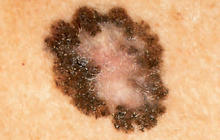Check your arms. If you count more than 11 moles, on your right arm in particular, you may be at a higher risk for skin cancer, say the authors of a new study.
Counting moles on the body is one way doctors get a bead on a patient's risk for skin cancer and the number of moles on the right arm may be a helpful predictor of the total number on the whole body, according to research published in the British Journal of Dermatology by scientists from King's College London.
The scientists used data from a UK study that tracked 3,594 female twins between January 1995 and December 2003. The twins received skin examinations during which nurses collected information on skin type, hair, eye color, freckles, and mole count on 17 body sites. The scientists also used information from a wider sample of men and women who participated in a UK melanoma case control study.

Is it skin cancer?
They reported that individuals with more than 11 moles on their right arm were nine times more likely to have more than 100 moles scattered across their whole body, meaning they were at a higher risk of developing a melanoma, the deadliest form of skin cancer.
"This study follows on from previous work to identify the best proxy site for measuring the number of moles on the body as a whole. The difference here is that it has been done on a much larger scale in a healthy Caucasian population without any selection bias and subsequently replicated in a case control study from a similar healthy UK population," said lead author Simone Ribero, of the college's Department of Twin Research & Genetic Epidemiology.
The findings could be a helpful way for general practitioners and primary care physicians to identify people more at risk for skin cancer, said Dr. Todd Ridky, an assistant professor of Dermatology at Penn Medicine, in Philadelphia.
"If they notice a lot of moles on someone's arm, they may want to refer them to dermatology, or take the time to conduct a more comprehensive skin exam. The study showed that lots of moles on the arm correlated very well with lots of moles in other places too," said Ridky, who was not involved in the study. He told CBS News he did not believe the new findings would change his routine much because dermatologists usually examine all of the skin of their patients yearly regardless of their mole count.
While having moles can mean you're more at risk, Ridky said, "Most moles fortunately don't turn into cancer. There are plenty of moley people who never have a cancer, but your risk of developing a melanoma is greater."
Ridky said individual genetics and the amount of time you've spent in the sun over your lifetime play into skin cancer risk. Skin cancer can appear in places on the body that don't have moles, too.
"There's no exact number, but somewhere between a quarter to a half of all melanomas start in a mole that had previously been benign," said Ridky.
Skin cancer is the most common form of cancer in the United States, according to the U.S. Centers for Disease Control and Prevention. Each year, more than 67,700 people are diagnosed with melanomas of the skin, and it results in more than 9,200 deaths.
Moles or no moles, Ridky said, "Everyone should be really cautious with sun exposure. Sun damage is a cumulative thing. The more you tan, the more damage you're getting. If you're someone who already has a lot of moles and increased risk of cancer is already a problem, then it's even more important that you be really vigorous about sun protection."
Finding a shady spot, wearing long sleeves and pants, donning a floppy hat, slathering on a broad spectrum sunscreen, and wearing sunglasses are your go-to weapons to fight sun damage any time of year, says the CDC.
Click Here For More Articles

No comments:
Post a Comment